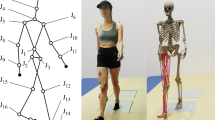Abstract
In biomechanics, recent mathematical models allow one to predict the muscular force response to functional electrical stimulations. The main concern of the present paper is to deal with the computation of optimized electrical pulses trains (for example in view of maximizing the final force response). Using the fact that functional electrical stimulations are modeled as Dirac pulses, our problem is rewritten as an optimal sampled-data control problem, where the control parameters are the pulses amplitudes and the pulses times. We establish the corresponding Pontryagin first-order necessary optimality conditions and we show how they can be used in view of numerical simulations.







Similar content being viewed by others
Notes
Archibald Vivian Hill (1886–1977) was the co-recipient of 1922 Nobel prize in Medicine for this equation.
References
Law, L.F., Shields, R.: Mathematical models of human paralyzed muscle after long-term training. J. Biomech. 40, 2587–2595 (2007)
Ding, J., Binder-Macleod, S.A., Wexler, A.S.: Two-step, predictive, isometric force model tested on data from human and rat muscles. J. Appl. Physiol. 85, 2176–2189 (1998)
Ding, J., Wexler, A.S., Binder-Macleod, S.A.: Development of a mathematical model that predicts optimal muscle activation patterns by using brief trains. J. Appl. Physiol. 88, 917–925 (2000)
Gesztelyi, R., Zsuga, J., Kemeny-Beke, A., Varga, B., Juhasz, B., Tosaki, A.: The Hill equation and the origin of quantitative pharmacology. Arch. Hist. Exact Sci. 66(4), 427–438 (2012)
Ding, J., Wexler, A.S., Binder-Macleod, S.A.: A predictive model of fatigue in human skeletal muscles. J. Appl. Physiol. 89, 1322–1332 (2000)
Ding, J., Wexler, A.S., Binder-Macleod, S.A.: Mathematical models for fatigue minimization during functional electrical stimulation. J. Electromyogr. Kinesiol. 13, 575–588 (2003)
Wilson, E.: Force response of locust skeletal muscle. Southampton University, Ph.D. thesis (2011)
Bourdin, L., Trélat, E.: Optimal sampled-data control, and generalizations on time scales. Math. Cont. Relat. Fields 6, 53–94 (2016)
Bourdin, L., Trélat, E.: Pontryagin maximum principle for optimal sampled-data control problems. In: Proceedings of 16th IFAC Workshop on Control Applications of Optimization CAO’2015 (2015)
Bourdin, L., Dhar, G.: Continuity/constancy of the Hamiltonian function in a Pontryagin maximum principle for optimal sampled-data control problems with free sampling times. Math. Control Signals Syst. (2019). https://doi.org/10.1007/s00498-019-00247-6
Bonnans, F., Giorgi, D., Maindrault, S., Martinon, P., Grélard, V.: Bocop—a collection of examples. Inria Research Report, Project-Team Commands, 8053 (2014)
Cots, O.: Contrôle optimal géométrique : méthodes homotopiques et applications. Ph.D. thesis, Université de Bourgogne, Dijon (2012)
Bakir, T., Bonnard, B., Rouot, J.: A case study of optimal input–output system with sampled-data control: Ding et al. force and fatigue muscular control model. Netw. Heterog. Med. 14(1), 79–100 (2019)
Yochum, M.: Contribution à la conception d’un électromyostimulateur intelligent. Thèse de doctorat, Instrumentation et informatique de l’image Dijon (2013)
Bakir, T.: Contribution à la modélisation, l’estimation et la commande de systèmes non linéaires dans les domaines de la cristallisation et de l’électrostimulation musculaire. HDR Université de Bourgogne (2018)
Gelfand, I.M., Fomin, S.V.: Calculus of Variations. Prentice Hall Inc., Englewood Cliffs (1963)
Schättler, H., Ledzewicz, U.: Geometric Optimal Control. Theory, Methods and Examples. Interdisciplinary Applied Mathematics, vol. 38. Springer, New York (2012)
Pontryagin, L.S., Boltyanskii, V.G., Gamkrelidze, R.V., Mishchenko, E.F.: The Mathematical Theory of Optimal Processes. Wiley, New York (1962)
Trélat, E.: Contrôle Optimal: théorie et Applications. Vuibert, Paris (2005)
Vinter, R.: Optimal control. Systems & Control: Foundations and Applications. Birkhäuser, Boston (2000)
Rackauckas, C., Nie, Q.: Differentialequations.jl—a performant and feature-rich ecosystem for solving differential equations in julia. J. Open Res. Softw 5, 15 (2017)
Hermes, H.: Lie algebras of vector fields and local approximation of attainable sets. SIAM J. Control Optim. 16(5), 715–727 (1978)
Bourdin, L., Dhar, G.: Optimal sampled-data controls with running inequality state constraints—Pontryagin maximum principle and bouncing trajectory phenomenon (2019). Submitted—available on HAL (hal id: hal-02160231)
Acknowledgements
This research paper benefited from the support of the FMJH Program PGMO and from the support of EDF, Thales, Orange. T. Bakir, B. Bonnard and J. Rouot are partially supported by the Labex AMIES.
Author information
Authors and Affiliations
Corresponding author
Additional information
Publisher's Note
Springer Nature remains neutral with regard to jurisdictional claims in published maps and institutional affiliations.
Appendix: Physical Descriptions of the Force–Fatigue Model
Rights and permissions
About this article
Cite this article
Bakir, T., Bonnard, B., Bourdin, L. et al. Pontryagin-Type Conditions for Optimal Muscular Force Response to Functional Electrical Stimulations. J Optim Theory Appl 184, 581–602 (2020). https://doi.org/10.1007/s10957-019-01599-4
Received:
Accepted:
Published:
Issue Date:
DOI: https://doi.org/10.1007/s10957-019-01599-4
Keywords
- Functional electrical stimulation
- Muscle mechanics
- Optimal control problems
- Sampled-data controls
- Pontryagin-type necessary optimality conditions




